A highly efficient organic sensitizer for dye-sensitized solar cells†
Suyoung
Hwang
a,
Jung Ho
Lee
a,
Chanmoo
Park
a,
Hoinglae
Lee
a,
Chaekyu
Kim
a,
Chiyoung
Park
a,
Mi-Hyeon
Lee
b,
Wanin
Lee
b,
Jihee
Park
c,
Kyungkon
Kim
c,
Nam-Gyu
Park
*c and
Chulhee
Kim
*a
aDepartment of Polymer Science and Engineering, Inha University, Incheon 402-751, Korea. E-mail: chk@inha.ac.kr; Fax: +82 32-865-5178; Tel: +82 32-860-7487
bDepartment of Chemistry, Inha University, Incheon 402-751, Korea
cCenter for Energy Materials, Korea Institute of Science and Technology (KIST), Seoul 136-791, Korea. E-mail: npark@kist.re.kr; Fax: +82 2-958-5309; Tel: +82 2-958-5365
First published on 14th September 2007
Abstract
We have synthesized a highly efficient organic dye for a dye-sensitized solar cell; the overall solar-to-energy conversion efficiency was 9.1% at AM 1.5 illumination (100 mW cm−2): short-circuit current density (Jsc) = 18.1 mA cm−2, open circuit photovoltage (Voc) = 743 mV and fill factor (ff) = 0.675.
Dye-sensitized solar cells (DSSCs) have been a target of intensive research in recent years due to their capability to convert solar light into electricity with low materials and production costs.1,2 One of the key material issues in DSSCs is the photosensitizer, which can exhibit high efficiencies in the conversion of solar energy into electricity. Ru complex photosensitizers such N3, N719 and Black dyes exhibit efficiencies higher than 10%.1,2 The performance of DSSCs based on organic dyes have also recently been remarkably improved. Therefore, it is expected that organic dyes could compete with Ru complexes in the near future.3
Organic dyes have many advantages as photosensitizers, such as large molar extinction coefficient, control of absorption wavelength, facile design and synthesis, and lower cost than Ru complexes.4 Efficient organic dyes such as coumarin, indoline, phthalocyanine and conjugated oligo-ene dyes have been reported.3–7 However, as yet, the use of organic dyes for DSSCs has a limitation due to their relatively low efficiency compared Ru complexes. Herein, we report a highly efficient dye which exhibits 9.1% overall solar-to-electric energy conversion efficiency.
As shown in Fig. 1, we have prepared the organic dye TA-St-CA, which contains a π-conjugated oligo-phenylenevinylene unit with an electron donor–acceptor moiety for intramolecular charge transfer and a carboxyl group as an anchoring unit for the attachment of the dye onto TiO2 nanoparticles.†
 | ||
| Fig. 1 Molecular structure of TA-St-CA dye. | ||
The UV-vis spectrum of TA-St-CA in Fig. 2 shows an absorption maximum at 386 nm in ethanol (ε = 31600 M−1 cm−1).
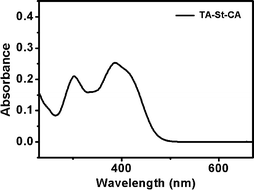 | ||
| Fig. 2 Absorption spectrum of TA-St-CA in ethanol. | ||
The HOMO level of the dye was estimated from its oxidation potential by using cyclic voltammetry, as shown in Fig. 3. The measurement was carried out using a Pt electrode in acetonitrile solution containing 0.1 M tetrabutylammonium tetrafluoroborate as an electrolyte. A standard ferrocene/ferrocenium (Fc/Fc+) system was used to calibrate the redox peak. The HOMO level was determined from the oxidation potential value with respect to ferrocene using an Ag/AgCl reference electrode. The HOMO level of TA-St-CA was −5.2 eV. The band gap of TA-St-CA was 2.4 eV, which was estimated from the absorption edge of the absorption spectrum. The LUMO of TA-St-CA, calculated from the HOMO and optical band gap, was −2.8 eV, which provides a favorable energy matching with the conduction level of TiO2 particles for the electron transfer from the LUMO of the dye to the conduction band of TiO2. The HOMO, LUMO and band gap energy results are summarized in Table 1.8
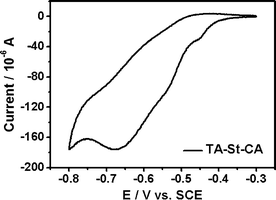 | ||
| Fig. 3 Cyclic voltammogram of TA-St-CA measured at a sweep rate of 20 mV sec−1. | ||
| Dye | E HOMO/eVa | E bandgap/eVb | E LUMO/eVc | J sc/mA cm−2 | V oc/mV | ff | η (%) |
|---|---|---|---|---|---|---|---|
| a Estimated from the oxidation potential, determined by cyclic voltammetry. b Estimated from the edge of absorption spectrum. c Calculated from the band gap and HOMO value. d See ref. 8. | |||||||
| TA-St-CA | −5.2 | 2.4 | −2.8 | 18.1 | 743 | 0.675 | 9.1 |
| N719 | −5.6d | 2.6d | −3.0d | 19.9 | 769 | 0.657 | 10.1 |
Fig. 4 shows the optimized molecular structure and frontier molecular orbitals of TA-St-CA. At the HOMO of the dye, electrons are homogeneously distributed in the π-conjugated oligo-phenylenevinylene unit and the triphenylamine electron donor moiety. However, at the LUMO level, with electronic excitation, intramolecular charge transfer induced electron movement from the donor site to the acceptor moiety of the dye. Therefore, excited electrons can be injected into the conduction band of TiO2via the carboxyl group adjacent to the cyano group.
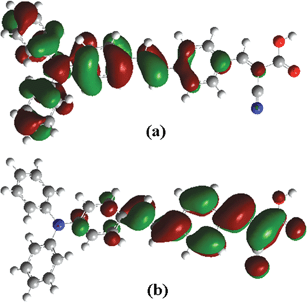 | ||
| Fig. 4 The frontier (a) HOMO and (b) LUMO orbitals of TA-St-CA optimized with TD-DFT at the B3LYP/6-31+G(d) level. | ||
A TA-St-CA DSSC was prepared, where a TiO2 film was composed of a double layer, with a ∼5 µm thick 400 nm particle film over-coated onto a 10 µm thick 20 nm particle film on FTO glass (Pilkington TEC8, ∼8 Ω/sq). The annealed TiO2 film was further treated with 0.2 M TiCl4 for 22 h at ambient temperature. Dye adsorption was performed with a 0.5 mM TA-St-CA solution in ethanol. For comparison, a N719 DSSC was prepared by the same procedure. Photocurrent and voltage were measured using a solar simulator equipped with a 1000 W ozone-free Xenon lamp and AM 1.5 G filter (Oriel), where the light intensity was adjusted with an NREL-calibrated Si solar cell with a KG-5 filter to 1 sunlight intensity (100 mW cm−2).
The photocurrent density–photovoltage (I–V) curve is shown in Fig. 5. The short circuit current density (Jsc) and open circuit voltage (Voc) of TA-St-CA were 18.1 mA cm−2 and 743 mV, respectively, with a fill factor (ff) of 0.675. The overall conversion efficiency (η) for TA-St-CA was 9.1%, under which conditions the efficiency of N719 was 10.1%.
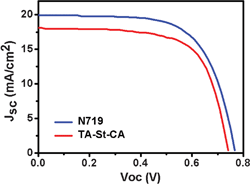 | ||
| Fig. 5 Photocurrent density–photovoltage curve of TA-St-CA under AM 1.5 G radiation (100 mW cm−2) (0.7 M N-methyl-N-butyl imidazolium iodide, 0.2 M LiI, 50 mM iodine, 0.5 M tert-butylpyridine in acetonitrile/3-methoxypropionitrile (50 : 50 V/V)). | ||
Fig. 6 shows the incident photon-to-current conversion efficiency (IPCE) data for TA-St-CA, where the IPCE data was collected at a low chopping speed of 10 Hz under a monochromatic beam generated by a 75 W Xenon light source. The IPCE value in the range 400 to 550 nm reached around 80%, which is higher than that for N719. The red-shift in the IPCE of TA-St-CA in Fig. 6, compared to the absorption spectrum of TA-St-CA in Fig. 1, can be ascribed to aggregation of the dye on titania.
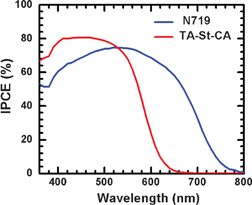 | ||
| Fig. 6 IPCE spectrum for a DSSC based on TA-St-CA. | ||
We are currently investigating the solar cell performance of π-conjugated donor–acceptor sensitizers having strong absorptions with wavelengths longer than 600 nm to achieve higher efficiencies. In addition, a tandem cell with TA-St-CA and N719 is under investigation because TA-St-CA and N719 showed good performance over different wavelength ranges. The detailed cell structure and photovoltaic characteristics will be published elsewhere.
This work was supported by a KIST internal project. We thank Dr Jae Woong Yu for help with the experiments.
Notes and references
- (a) B. O'Regan and M. Grätzel, Nature, 1991, 353, 737 CrossRef CAS; (b) M. Grätzel, Photochem. Photobiol., 2003, 4, 145 CrossRef CAS; (c) M. Grätzel, Photochem. Photobiol., 2004, 164, 3 CrossRef CAS.
- (a) M. K. Nazeeruddin, S. M. Zakeeruddin, R. Humphry-Baker, M. Jirousek, P. Liska, N. Vlachopoulos, V. Shklover, C. Fischer and M. Grätzel, Inorg. Chem., 1999, 38, 6298 CrossRef CAS; (b) A. Hagfeldt and M. Grätzel, Chem. Rev., 1995, 95, 49 CrossRef CAS; (c) A. Hagfeldt and M. Grätzel, Acc. Chem. Res., 2000, 33, 269 CrossRef CAS; (d) M. Grätzel, Nature, 2001, 414, 338 CrossRef CAS; (e) M. K. Nazeeruddin, P. Péchy, T. Renouard, S. M. Zakeeruddin, R. Humphry-Baker, P. Comte, P. Liska, L. Cevey, E. Costa, V. Shklover, L. Spiccia, G. B. Deacon, C. A. Bignozzi and M. Grätzel, J. Am. Chem. Soc., 2001, 123, 1613 CrossRef CAS.
- (a) S. Ferrere, A. Zaban and B. A. Gregg, J. Phys. Chem. B, 1997, 101, 4490 CrossRef CAS; (b) K. Hara, T. Horiguchi, T. Kinoshita, K. Sayama, H. Sugihara and H. Arakawa, Sol. Energy Mater. Sol. Cells, 2000, 64, 115 CrossRef CAS; (c) K. Sayama, K. Hara, N. Mori, M. Satsuki, S. Suga, S. Tsukagoshi, Y. Abe, H. Sugihara and H. Arakawa, Chem. Commun., 2000, 1173 RSC; (d) K. Sayama, K. Hara, S. Tsukagoshi, Y. Abe, Y. Ohga, A. Shinpo, S. Suga and H. Arakawa, New J. Chem., 2001, 25, 200 RSC; (e) S. Kim, J. K. Lee, S. O. Kang, J. Ko, J.-H. Yum, S. Fantacci, F. D. Angelis, D. D. Censo, M. K. Nazeeruddin and M. Grätzel, J. Am. Chem. Soc., 2006, 128, 16701 CrossRef CAS.
- (a) K. Hara, Z. S. Wang, T. Sato, A. Furube, R. Katoh, H. Sugihara, Y. Dan-oh, C. Kasada, A. Shinpo and S. Suga, J. Phys. Chem. B, 2005, 109, 15476 CrossRef CAS; (b) K. Hara, T. Sato, R. Katoh, A. Furube, Y. Ohga, A. Shinpo, S. Suga, K. Sayama, H. Sugihara and H. Arakawa, J. Phys. Chem. B, 2003, 107, 597 CrossRef CAS; (c) D. P. Hagberg, T. Edvinsson, T. Marinado, G. Boschloo, A. Hagfeldt and L. Sun, Chem. Commun., 2006, 2245 RSC.
- (a) K. Hara, Y. Tachibana, Y. Ohga, A. Shinpo, S. Suga, K. Sayama, H. Sugihara and H. Arakawa, Sol. Energy Mater. Sol. Cells, 2003, 77, 89 CrossRef CAS; (b) K. Hara, M. Kurashige, S. Ito, A. Shinpo, S. Suga, K. Sayama and H. Arakawa, Chem. Commun., 2003, 252 RSC; (c) K. Hara, Y. Dan-oh, C. Kasada, Y. Ohga, A. Shinpo, S. Suga, K. Sayama and H. Arakawa, Langmuir, 2004, 20, 4205 CrossRef CAS; (d) K. Hara, T. Sato, R. Katoh, A. Furube, T. Yoshihara, M. Kurashige, S. Ito, A. Shinpo, S. Suga and H. Arakawa, Adv. Funct. Mater., 2005, 15, 246 CrossRef CAS; (e) T. Horiuchi, H. Miura, K. Sumioka and S. Uchida, J. Am. Chem. Soc., 2004, 126, 12218 CrossRef CAS; (f) M. Liang, W. Xu, F. Cai, P. Chen, B. Peng, J. Chen and Z. Li, J. Phys. Chem. C, 2007, 111, 4465 Search PubMed.
- T. Kitamura, M. Ikeda, K. Shigaki, T. Inoue, N. A. Anderson, X. Ai, T. Lian and S. Yanagida, Chem. Mater., 2004, 16, 1806 CrossRef CAS.
- D. P. Hagberg, T. Edvinsson, T. Marinado, G. Boschloo, A. Hagfeldt and L. Sun, Chem. Commun., 2006, 2245 RSC.
- M. K. Nazeeruddin, F. D. Angelis, S. Fantacci, A. Selloni, G. Viscardi, P. Liska, S. Ito, B. Takeru and M. Grätzel, J. Am. Chem. Soc., 2005, 127, 16835 CrossRef CAS.
Footnote |
| † Electronic supplementary information (ESI) available: Detailed synthetic procedures and spectral characterization. See DOI: 10.1039/b709859f |
| This journal is © The Royal Society of Chemistry 2007 |
